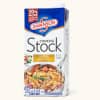Making Stock: Pot versus Pressure Cooker
Cooking stock in a pressure cooker is faster than cooking it in a regular pot, but we wondered if this method would change the flavor, too.
Obviously, cooking stock in a pressure cooker is faster than cooking it in a regular pot, but we wondered if this method would change the flavor, too. To find out, we made a simple chicken stock by simmering 3 pounds of chicken wings (which are both flavorful and loaded with collagen) in 3 quarts of water in a large Dutch oven on the stovetop for 2 hours. We made an identical batch of stock in a pressure cooker, cooking it for 1½ hours.
To our surprise, both the color and the flavor of the stocks were noticeably different from each other. The pressure-cooked broth was darker, with a more complex, meaty flavor, while the broth prepared in a Dutch oven had a cleaner, purer chicken taste. What gives? It turns out that the high temperature inside a pressure cooker does more than just speed up the cooking time. It also promotes more extraction of flavor compounds from the skin and bones while encouraging the breakdown of proteins into peptides, which produce rich meatiness. Without these additional flavors, the broth cooked in a Dutch oven tasted more like chicken but was less meaty-tasting overall.
Do we have a favorite? Not exactly. When clean chicken flavor is the goal—as in a simple chicken soup—we might prefer the stock cooked in the Dutch oven. But for adding meaty richness to stews and braises, pressure-cooked chicken stock is an asset.
PRESSURE POINT: Pressure-cooked stocks taste more complex than those made in a pot.



